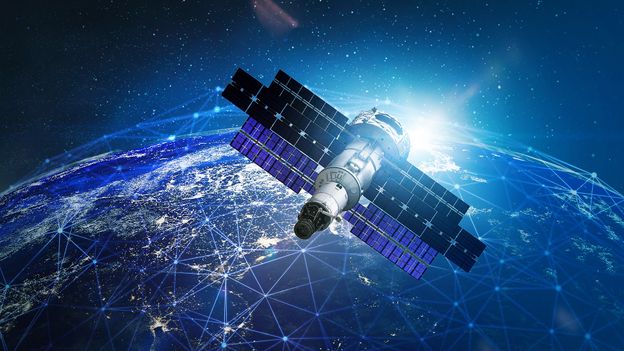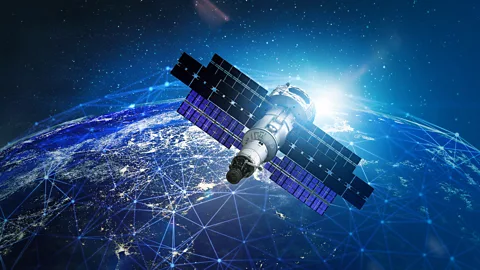 Getty Images
Getty ImagesSynthetic Aperture Radar (SAR) allows satellites to bounce radar signals off the ground and interpret the echo – and can even peer through clouds.
Clouds roll in two thirds of the world at any time, preventing conventional satellites from seeing much of the planet.
But now a declassified technology known as Synthetic Aperture Radar (SAR) can be installed on satellites to “see” the Earth’s surface in the dark, through clouds (or forest fire smoke) to provide a continuous unobscured view of our planet, and show changes in the earth’s surface in great detail.
This technology, previously used to power only a relatively small number of large commercial satellites, is now being combined with low-Earth orbit constellations of low-cost nanosatellites by start-ups such as Ice eye and Capella space. The goal is to provide continuous observation almost anywhere on the planet for everyone from non-governmental organizations to military customers.
“SAR satellites are capable of wider coverage and higher resolution images than their optical rivals, day and night. You don’t have to wait for the clouds to clear, you don’t have to wait for the rain to stop,” says Holly George-Samuels, a scientist at the security supplier and QinetiQ defenses. “If you need information, you can go get it now and it will be better than an optical image.
“With centimeter resolution, you can even see sheep tracks across the grass.”
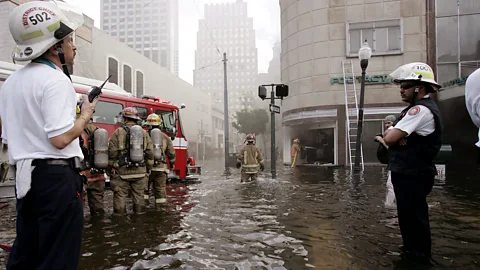 Getty Images
Getty Images“Already at the beginning of 2018, people told us that it was technologically impossible to make a small version of a SAR satellite,” says Eric Jensen, CEO of the US branch of the Finnish start-up Iceye. “It just couldn’t, and even if it did, you’d never get enough power out of something the size of an American dishwasher.
“In pure business, we said, ‘Thank you very much for your feedback, but we’ll try anyway.’ We now build satellites 100 times cheaper than 20 years ago and launch them four to five times faster.
“We are at a tipping point. SAR is poised to change the way we observe our own planet.
They are used to it this year quickly reveal damage caused by the Baltimore Francis Scott Key Bridge incident.
But their potential does not end there. NASA scientist and SAR specialist Cathleen Jones uses satellites “to observe all kinds of hazards.”
Most of California’s water is in the north, but most of its population is in the south, and the California Aqueduct transports water from one to the other. “If the aqueduct sinks at one point, the amount of water flowing through that point is reduced,” says Jones. “So the SAR allows me to look for movement in the aqueduct down to a centimeter.
Similarly, it has used the technology to understand the reasons behind sinkholes in coastal areas such as New Orleans.
2024 Hurricane Season is set to officially begin on June 1 in the Atlantic Ocean, Gulf of Mexico and Caribbean Sea with up to 25 named storms expected. SAR can play an important role in subsequent clarification.
“We look at all the satellite images and try to figure out where the oil spill happened,” Jones says, “and that’s especially important after the hurricane in the Gulf of Mexico, where some of the rigs will be destroyed or damaged.”
Jones does this by measuring the reflectance of light. Oil will make the surface appear flatter and darker in the image.
“We can use this technology to find out where the oil is and where it’s going – very quickly,” says Jones. “It’s much more dangerous when slime moves up the coast into a wetland ecosystem or where people live.”
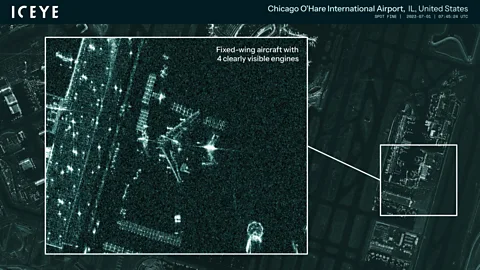 Ice eye
Ice eyeSo how does it work? While optical satellites rely on light from the Sun to illuminate an area of interest on the Earth’s surface, SAR actually creates its own “sunlight” by sending strong microwave signals from the satellite down to the ground – and which are not affected by weather conditions.
By accurately analyzing the reflected signals, a highly detailed radar image of the area is created. Driving over the same area frequently means that SAR is particularly good at identifying changes on the ground down to the size of a fingernail. However, these images look very different from what we see on Google Earth.
“It’s more difficult to understand SAR images than an optical image because what you have is a high-resolution ground reflectance map of the scene rather than a photographic image,” says George-Samuels. difficult to interpret and analysts must be trained to understand what they are saying. But artificial intelligence can be trained to interpret images for us.
But this technology is really more about collecting data than images. “No one really wants a SAR image: they want to look at the data,” he says. “I spoke to an ocean scientist who models ocean currents and they use the SAR data product to show sea level change.
Much of the interest in SAR dates back to a patent granted in 1954. The now declassified Project Quill satellite launched by the United States 10 years later in 1964 is considered the first equipped with revolutionary technology.
Yet only now—almost 60 years later—is synthetic aperture radar getting the headlines the technology deserves.
Seventy years since the first patent, falling component prices have fueled this latest phase of development. “The first—and most important—is the ability to miniaturize components to build small, low-cost satellites and build them quickly to reduce costs,” says Beau Legeer, director of imaging and remote sensing at software company Esri. “Then there’s the ability to launch these satellites easier, cheaper and faster than ever before, the availability of venture capital to fund these start-ups and the early success of SAR in this broader role.
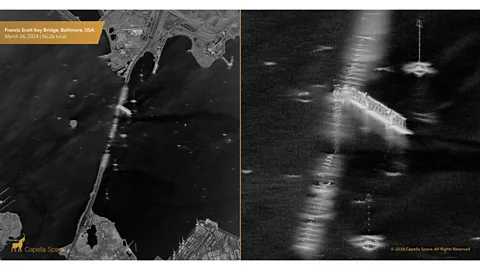 Capella space
Capella space“One of the superpowers of SAR is that it’s not affected by things that affect optical images, like different angles of the sun and shadows, which makes it a very consistent source of data, which is also very good for AI machine learning applications.”
For Iceye’s Eric Jensen, a change in the US government’s attitude is essential to the start of SAR use. “In the US, the technology was seen as something the government needed to keep under control, because in the wrong hands, enemy countries could look at every allied military installation day and night in high definition,” he says. “The technology was then largely left to European nations and Canada to develop commercially… with satellites costing $400m-$500m (£320m-£400m) each, taking four years to build and two years to tune when were in orbit.
“Instead of the US holding back the development of this new technology, now it’s saying, ‘let’s try to use it, let’s welcome it’. What we’ve seen is that the US government is much more willing to work with allied nations that are developing basic technologies.” than ever in the past.”
Cathleen Jones agrees that a “big, big reason” why SAR is coming to the fore right now is because the technology is improving. “But there’s also the other big factor, which is that this data cost a lot of money, and then the European Space Agency and NASA let their data be freely used, and then people started using it.”
Similarly, “all data will be free to use” from the state-of-the-art joint NASA-Indian Space Research Organization (ISRO) Nisar satellite which is about to start.
Others have a different opinion. “To be honest, I’m not sure revolution is the right word,” says Bleddyn Bowen, author of Original Sin: Power, Technology and War in Outer Space. “It’s been around for a long time in the military and intelligence communities, and it’s only in the news now because there are multiple commercial providers and the data is now more accessible to government and private industry than in the past.”
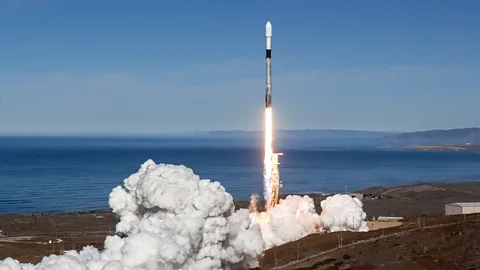 Ice eye
Ice eyeHowever, the future of SAR may depend on solving the complex engineering conundrum of increasing the size of the satellite, especially the antennas and solar panels used to power it, while keeping them as small as possible so they can be more easily controlled. commencement. “A large antenna is extremely useful,” says Frank Backes, CEO of Capella Space, “for increasing image fidelity. It’s an interesting physics problem.”
It will also depend on the development of orbital communication networks such as Kuiper from Amazon, which can be joined by other spacecraft in low Earth orbit. “This will allow us to transmit our data directly to the user,” says Backes, “and reduce the time it would take from an hour or two to less than 15 minutes. And the nice thing is that these networks are growing right now.”
However, the use of artificial intelligence is essential for its future. “AI will excel at taking useful information as a data product and presenting it to a human,” says George-Samuels.
Its proponents argue that SAR will have a direct impact on society simply by making supply chains run more smoothly, agricultural yields more predictable, or—perhaps more importantly—being kept out of harm’s way during floods or wildfires.
George-Samuels believes SAR will provide more effective environmental monitoring. “With more information, we can act faster,” he says. “It will save lives.
Others think even bigger: “It will mean transparency on a planetary scale,” says Backes. “So in a conflict situation, having information available to the general public about what’s going on will remove the fog of war, and we’ve already seen that in the Russia-Ukraine conflict.”
But not everyone is on board. Some fear the dangers of this technology. Its potential to invade individual privacy, its use for corporate espionage, and even if it could be used to plan terrorist attacks.
Is hype also a factor? “Private imaging companies always want to create the impression that we’re going to be transparent,” says Bowen. “We’ll be able to see anything that’s going to happen, and we’ll get alerts about everything that’s going to happen. But we’ll never have full transparency and full information, because pictures are not the equivalent of live video and don’t tell you everything you need to know.”
In January 2022, everyone saw the Russians massing on the Ukrainian border, but no one could see inside the head of Russian leader Vladimir Putin to know if there would be war or not. “Also, we never got any pictures or information about anything that was going on on the Ukrainian side. The United States had complete control of the shutter.”
